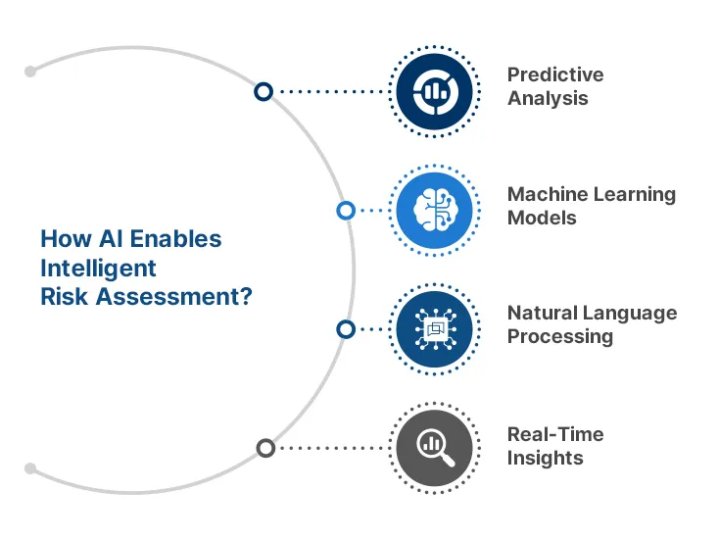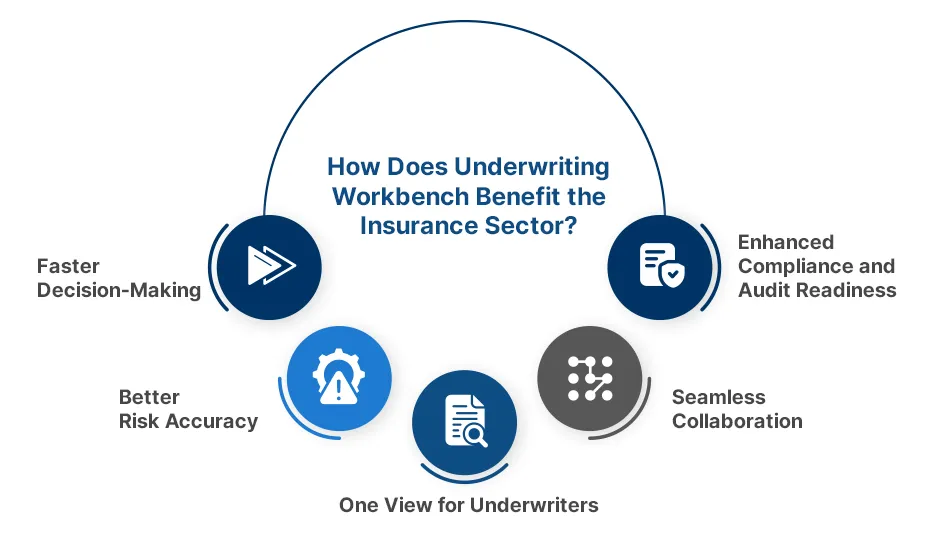Recommended Blogs

Underwriting Enters the AI Age. From Playbooks to AI Workbenches
Table of Content
Manual underwriting is quickly becoming a thing of the past. Today, AI is taking the lead, delivering faster decisions with unmatched accuracy. Across the globe, underwriting is one of the areas most significantly transformed by AI, reshaping how risks are assessed, and policies are issued.
Underwriting has moved from rigid checklists to intelligent systems that respond in real time. With AI at the center, it now reads signals from climate trends, customer behavior, and shifting markets to make faster and more informed decisions. Static models and manual inputs no longer match the pace or complexity of today’s risk landscape.
This evolution is not about removing human expertise; it is about amplifying it. AI supports underwriters by surfacing hidden patterns, flagging inconsistencies early, and learning continuously from new data. It creates room for better judgment, sharper pricing, and deeper risk insight. Processing times for even the most complex policies have dropped by 31%, while the accuracy of risk assessment has surged by 43%.
Even with clear gains, some insurers remain cautious. Concerns around trust, transparency, and control slow down transformation. But in this environment, waiting has its own cost. The advantage now belongs to those who build underwriting around intelligence and move with confidence into what comes next.
This blog explores why AI-powered underwriting workbenches are now mission-critical and how they can unlock speed, precision, and growth for future-ready insurers.
Key Takeaways
- Agentic AI can reduce underwriting processing time by up to 90% and handle routine tasks.
- AI-powered underwriting boosts risk evaluation accuracy by 43% with predictive models.
- AI workbenches empower underwriters to make faster decisions by unifying tools.
- The global AI in insurance market is projected to reach $45.74 billion by 2031.
What is an Underwriting Workbench?
Underwriting workbench is one digital workspace designed to help underwriters manage the entire underwriting process efficiently. The system brings together various tools, data sources, and workflows into a single, unified interface.
As per a report, global AI in insurance is expected to reach $45.74 billion by 2031, pointing to the need for the insurance sector to adopt this technology quickly. The underwriting workbench eliminates the need to switch between multiple systems. It further reduces manual efforts and enables faster decision-making in the business.
How AI Enables Intelligent Risk Assessment?
Artificial Intelligence has transformed underwriting by turning raw data into actionable insights. It empowers underwriters to make faster and consistent decisions.
Predictive Analysis
Underwriters can adopt a proactive approach to risk assessment with the use of predictive analysis. By analyzing past claims and outside data sources, AI can spot trends that indicate future risk exposure. Due to this, insurers are able to predict the probability of different occurrences, such as default or property damage, before they happen.
Machine Learning Models
ML models are built to learn from new data and outcomes continuously. It helps in improving underwriting and these models adapt and refine themselves to make the process more reliable and efficient. The dynamic nature makes risk scoring precise over time and provides custom underwriting decisions with emerging real-world conditions.
Natural Language Processing
Large amounts of data, such as doctors’ notes and inspection reports, are often stored in unstructured formats. NLP helps AI systems read and understand this data to further extract key insights and highlight red flags. It expands the scope of risk assessment and allows underwriters to work with a complete picture.
Real-Time Insights
Underwriters can also receive contextual and real-time recommendations from AI-powered platforms. It highlights irregularities, recommends risk scores, and imports data from third parties to reduce the turnaround times. Underwriters no longer have to wait days for reports and can make decisions and gather data in seconds.
What is the Role of Agentic AI in Underwriting?
Agentic AI presents a novel paradigm in which intelligent beings behave independently within predetermined parameters rather than only supporting underwriters. Before a human underwriter intervenes, these AI programs can evaluate applications, identify irregularities, ask for more details, and even pre-score risk.
Agentic AI drastically improves efficiency and consistency by handling routine assessments and revealing just the edge cases. As per a report, it helps reduce processing time by up to 90%. While the agents maintain speed, accuracy, and always-on intelligence throughout the underwriting lifecycle, this change frees up underwriters to concentrate on higher-order judgments.
How Does Underwriting Workbench Benefit the Insurance Sector?
The best way to increase decision-making speed, risk accuracy, and compliance is through AI-powered underwriting. Among its main advantages are:
Faster Decision-Making
Underwriting procedures are streamlined by an AI-powered workbench that takes data sources into account and automates tedious tasks. Underwriters no longer have to wait on manual reports or waste time switching between tools.
Decision-making gets faster, and the quote-to-bind cycles are reduced from days to hours. As per a report, businesses that use AI notice 30-50% faster quote-to-bind cycles.
Better Risk Accuracy
Another benefit of underwriting workbench is better risk evaluation and analysis of broader data ranges. More accurate risk assessments with consistent risk assessments, reduced human bias, also minimized underwriting errors result. As time passes, this precision can lower claim losses. Additionally, it is of help to portfolio quality.
One View for Underwriters
The unified workbench brings various functions, such as data ingestion, document review, scoring models, and collaboration tools, together in one place. It gives underwriters a complete 360-degree view of every case and enables them to work more efficiently and with greater confidence.
Seamless Collaboration
Underwriting teams can collaborate in real-time with integrated communication and task management tools. Whether it is raising a flag for high-risk cases to get a second opinion or syncing with claims and sales teams, the workbench facilitates cross-functional alignment.
Companies can gain a 5-10% increase in new-premium growth and customer retention with an AI-powered underwriting workbench.
Enhanced Compliance and Audit Readiness
Every action that is taken within an AI-powered workbench is logged, traceable, and explainable. It helps underwriters justify their decisions and ensures regulatory compliance. With built-in documentation and audit trails, insurers can now respond swiftly to audits and maintain strong governance practices.
How to Build AI-Powered Underwriting at Scale?
Adopting new technologies is only one aspect of transforming underwriting; another is rethinking how risk choices are made in a society prioritizing digitalization. The true potential is in creating intelligent, scalable underwriting systems that change with the company as Artificial Intelligence, Natural Language Processing, and low-code platforms advance.
Thus, insurers need to adopt a well-defined, modular approach to modernization:
Begin Modestly and Scale Wisely:
Start with specific use cases such as predictive risk score or submission triage. Rapid victories provide confidence and momentum.
Become Cloud-Native:
An enterprise-grade, unified, and cloud-based workbench that enables quicker integrations and simpler upgrades.
Enable Human and AI Collaboration:
The purpose of this is to expedite decision cycles, reduce fatigue, and give underwriters useful information to improve decision-making.
Turn Underwriting into Strategic Growth with TxMinds
Underwriters do much more than just execute a back-office procedure. Our AI-powered underwriting services are a powerful business enabler that boosts competitive advantage, profitability, and agility.
The capacity for effective underwriting and cleverness will distinguish market leaders from followers as the insurance industry gathers data and then focuses on customers.
TxMinds helps insurers rethink underwriting by combining next-generation AI. We have a combination of deep subject experience and digital engineering. Now is the perfect time to modernize underwriting and use AI to its full potential.
Book a consultation with our experts and gain a competitive edge.
Summary
The possibilities in insurance underwriting have been reimagined by AI-powered risk analysis and a single underwriting workbench. By eliminating manual inefficiencies, enabling real-time insights, and supporting more accurate risk decisions, insurers can turn underwriting into a true strategic advantage. The insurance industry greatly benefits from AI-powered underwriting. In light of the evolving market trends, insurers ought to modernize their underwriting ecosystems.
FAQs
-
An underwriting workbench is a centralized digital platform that integrates all the tools, data, and workflows needed for underwriting, enabling faster, more accurate, and consistent decision-making.
-
AI enhances underwriting by automating data analysis, predicting risks more accurately, extracting insights from unstructured data, and providing real-time decision support.
-
Insurers can achieve faster quote-to-bind cycles, improved risk accuracy, reduced operational costs, fraud detection mechanism, better compliance, and enhanced customer retention.
-
No. AI supports underwriters by handling repetitive tasks and data analysis, allowing them to focus on strategic decision-making and complex risk cases.
-
Begin with a modular approach-start small with use cases like risk scoring or triage, adopt cloud-native platforms, and ensure seamless integration across systems for scalability.
Discover more
Stay Updated
Subscribe for more info




